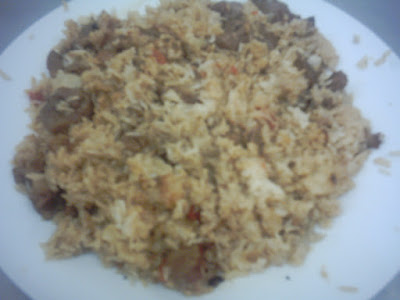Polish: baranina
Portuguese: carneiro
Norwegian: lammedeig
Russian: Баранина
Dutch: schapevlees
Danish: fårekød
Czech: skopové
French: mouton
Breton: kig-dañvad
Shona: nyama yehwai
Makluba (
مقلوبة) is a
Palestinian dish from
mutton, rice and vegetables, but as far as I know eaten also in the rest of Levant countries. In Arabic its name means nothing else but... "
upside down", and Spaniards call it "
arabic paella". Factually, there are many similarities between those two dishes: both contain similar ingredients (rice, vegetables, meat) cooked in one pan and were rather a poor dish, prepared from the resting pieces of meat and differrent vegetables. Today it is eaten usually on fridays and served to the guests to offer them respect and honour. But why is it called "upside-down"? After cooking, you should invert the content of the pan into a plate. If you are lucky, it will conserve the shape of the pan, but mine didn't. Anyway, taste counts ;)
(ps. the pics are of a bad quality; I am sorry for that, but you have to believe me, this dish tastes wonderful even for me, who never liked meat too much)
2 medium aubergines
2 big tomatoes
1 medium couliflower
1 big onion + 1 small onion
1/2 kg mutton shoulder*
1 1/2 cup basmati rice
cumin
1. Chop the small onion, fry until smelling and golden, add mutton (*I had about 3/4 kg mutton with bones and after cooking and throwing the bones away, there was 1/2 kg meat), fry a little bit and cook in 1/2-3/4 l water until soft
2. Peel and slice aubergines, sprinkle with salt and set aside until drops appear on its surface. Drain with a kitchen paper towel or with your hand, and fry
3. Divide cauliflower into chunks, cook for a very short time (about 5 minutes) in water with salt cumin

(beginning with tomatoes and moving as a clock needle: tomato slices, fried eggplants, mutton chunks, mutton broth, eggplants being drained, fried cauliflower chunks)
4. Wash rice, divide meat chunks from the broth
5. Prepare the pan: put some spoons of the fat that swims on the surface of your broth or spread some spoons oil, and cover the bottom of the top with thick slices of the big onion. This is actually my invention cause I like the taste of onions and here onions serve as a protection layer instead of backing sheet (some people put baking sheet on the bottom of the pan, some put tomatoes). The second layer are thick slices of tomato and the third are slices of fried eggplant. Then you put 1/2 amount of washed, drained rice. Next layer should be meat, then cauliflower, then the rest of the rice and then eggplant slices.




6. When ready with the layers, pour the broth over the dish. Broth should reach the top of the last layer, if it does't, add water. Taste the broth if there is enough salt. Cover the pan with aluminium sheet and simmer until rice is ready (usually about 1/2 hour). After that try to take the makluba away as it was a cake :) You can sprinkle it with toasted pine nuts and serve with yoghurt.

































